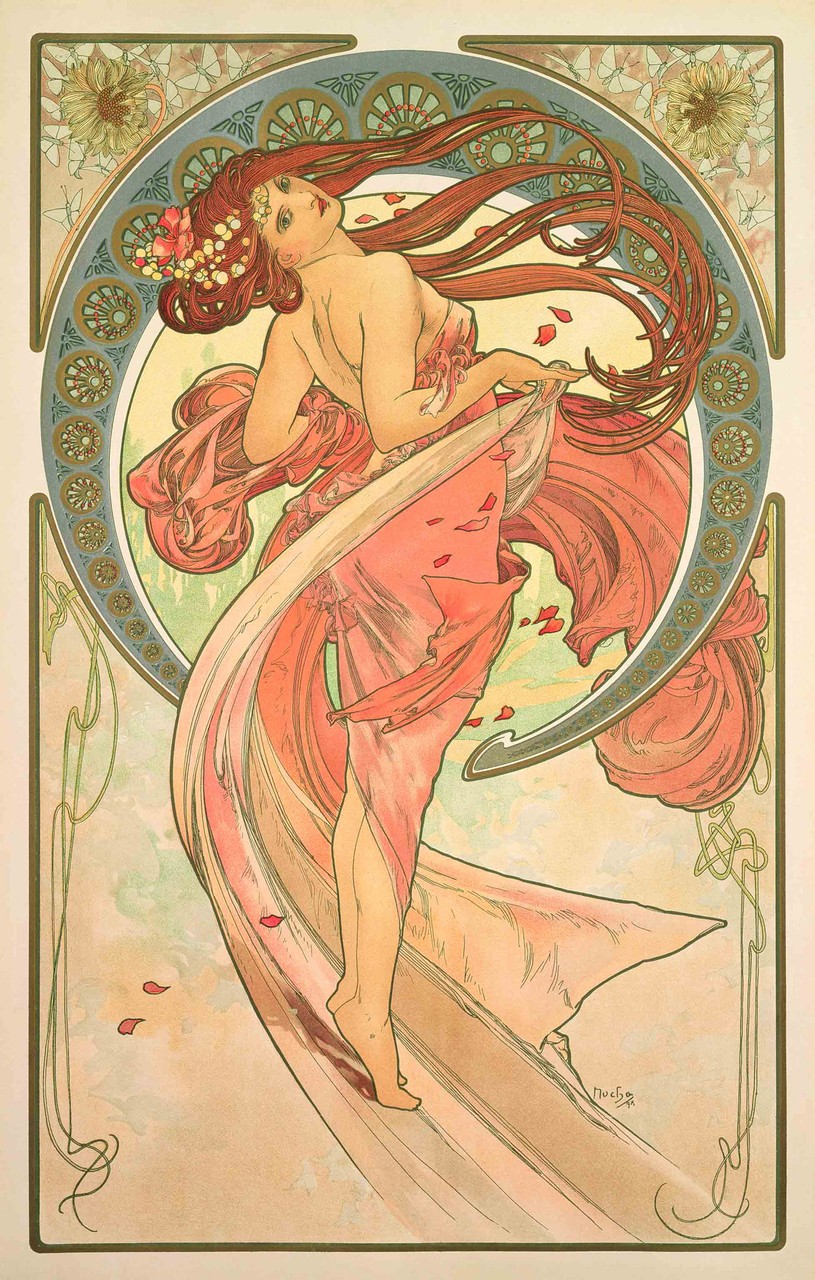Alphonse Mucha
03 Feb - 03 Jun 2018

Alphonse Mucha, Self-portrait with posters for Sarah Bernhardt in his studio, Rue du Val-de-Grâce, Paris, c. 1901. © Mucha Trust 2017
ALPHONSE MUCHA
Beauty pervades Mucha’s art, which remains an inspiration.
3 February - 3 June 2018
Plants, women and ornaments wind around one another in Mucha’s beautiful pictorial world. The Czech-born Art Nouveau artist Alphonse Mucha (1860-1939) won great fame in Paris in the period around the turn of the last century. His posters occupied public space, and he made no distinction between painting, design and advertising. His prolific production was a tribute to beauty, physical and spiritual, based on the wish to improve mankind and the world. In Mucha’s works nature and the city, plants and humans, goodness and consumption all merge. If you are looking for ‘mindfulness’ and ‘slow living’, Mucha’s aesthetic universe is the place to go.
ARKEN’s major exhibition unfolds Mucha’s art in all its breadth with painting, posters, advertisements, photographs, design, jewellery and interiors. At the same time it presents examples of the psychedelic art of the 1960s and 1970s along with Japanese and Korean manga up until today, which is strongly inspired by Mucha’s art.
“Divine nature speaks to our soul... She awakes in our hearts joy and happiness by the simple lines, proportions and colour of a small flower.”
Alphonse Mucha
The women in Mucha’s art
The French star actress Sarah Bernhardt (1844-1923) was an important figure in Mucha’s life and works. In 1894 Mucha made his first poster for the play Gismonda with Bernhardt in the leading role, and it led to Mucha’s breakthrough. This was the starting point for many years of friendship and cooperation between the two.
Young, beautiful, healthy woman are often the main motif in Mucha’s art. In Mucha’s advertisement all the products are sold through the beauty of women. Women function as a humanization of nature or as an allegory of a historic occasion or a political message. Especially in Mucha’s late works, Slavic nationalism plays a steadily increasing role associated with the wish for Czechoslovakian independence. In these works the woman is a national symbol. Mucha’s women are strong, and their strength is essential to the meaning of the artwork.
Mucha the photographer
As early as 1893 Mucha had his first camera, and as the image-maker he was, he plunged into the new medium with great curiosity. Throughout life Mucha photographed his surroundings, himself and his models, and he often used these photos as part of his study material. The exhibition includes many photographs by Mucha and elucidates how they left their traces on his other art.
Beauty pervades Mucha’s art, which remains an inspiration.
3 February - 3 June 2018
Plants, women and ornaments wind around one another in Mucha’s beautiful pictorial world. The Czech-born Art Nouveau artist Alphonse Mucha (1860-1939) won great fame in Paris in the period around the turn of the last century. His posters occupied public space, and he made no distinction between painting, design and advertising. His prolific production was a tribute to beauty, physical and spiritual, based on the wish to improve mankind and the world. In Mucha’s works nature and the city, plants and humans, goodness and consumption all merge. If you are looking for ‘mindfulness’ and ‘slow living’, Mucha’s aesthetic universe is the place to go.
ARKEN’s major exhibition unfolds Mucha’s art in all its breadth with painting, posters, advertisements, photographs, design, jewellery and interiors. At the same time it presents examples of the psychedelic art of the 1960s and 1970s along with Japanese and Korean manga up until today, which is strongly inspired by Mucha’s art.
“Divine nature speaks to our soul... She awakes in our hearts joy and happiness by the simple lines, proportions and colour of a small flower.”
Alphonse Mucha
The women in Mucha’s art
The French star actress Sarah Bernhardt (1844-1923) was an important figure in Mucha’s life and works. In 1894 Mucha made his first poster for the play Gismonda with Bernhardt in the leading role, and it led to Mucha’s breakthrough. This was the starting point for many years of friendship and cooperation between the two.
Young, beautiful, healthy woman are often the main motif in Mucha’s art. In Mucha’s advertisement all the products are sold through the beauty of women. Women function as a humanization of nature or as an allegory of a historic occasion or a political message. Especially in Mucha’s late works, Slavic nationalism plays a steadily increasing role associated with the wish for Czechoslovakian independence. In these works the woman is a national symbol. Mucha’s women are strong, and their strength is essential to the meaning of the artwork.
Mucha the photographer
As early as 1893 Mucha had his first camera, and as the image-maker he was, he plunged into the new medium with great curiosity. Throughout life Mucha photographed his surroundings, himself and his models, and he often used these photos as part of his study material. The exhibition includes many photographs by Mucha and elucidates how they left their traces on his other art.

